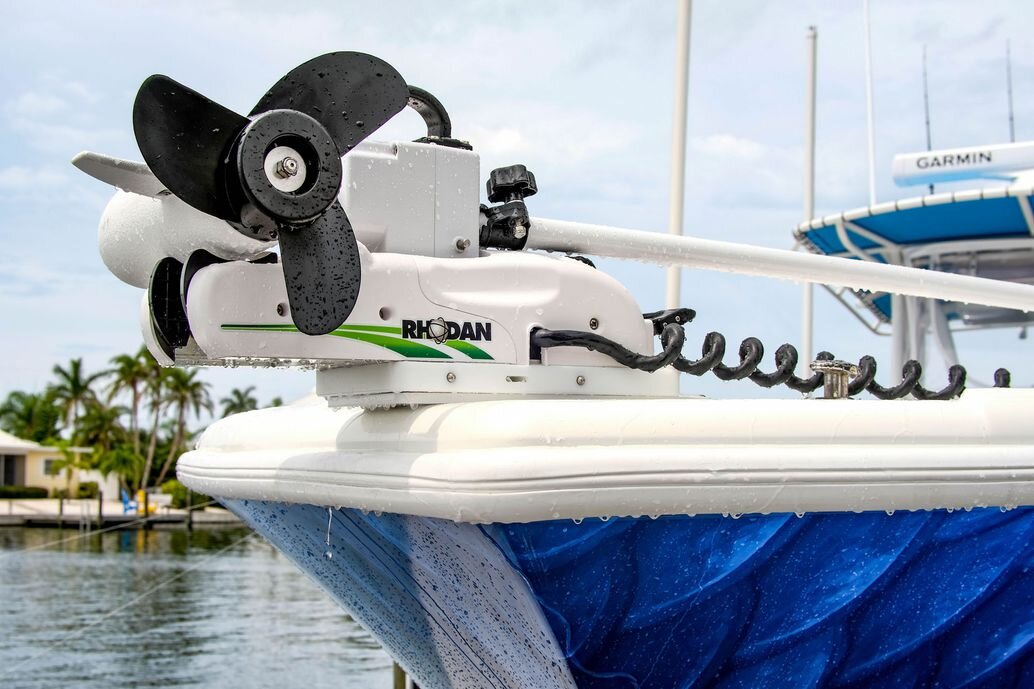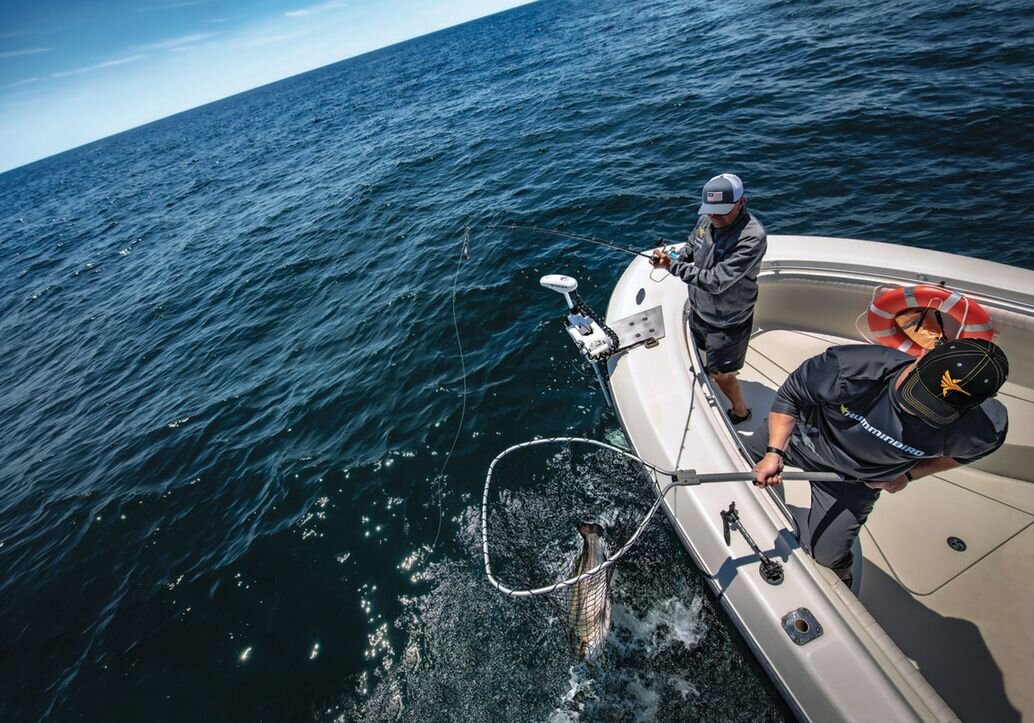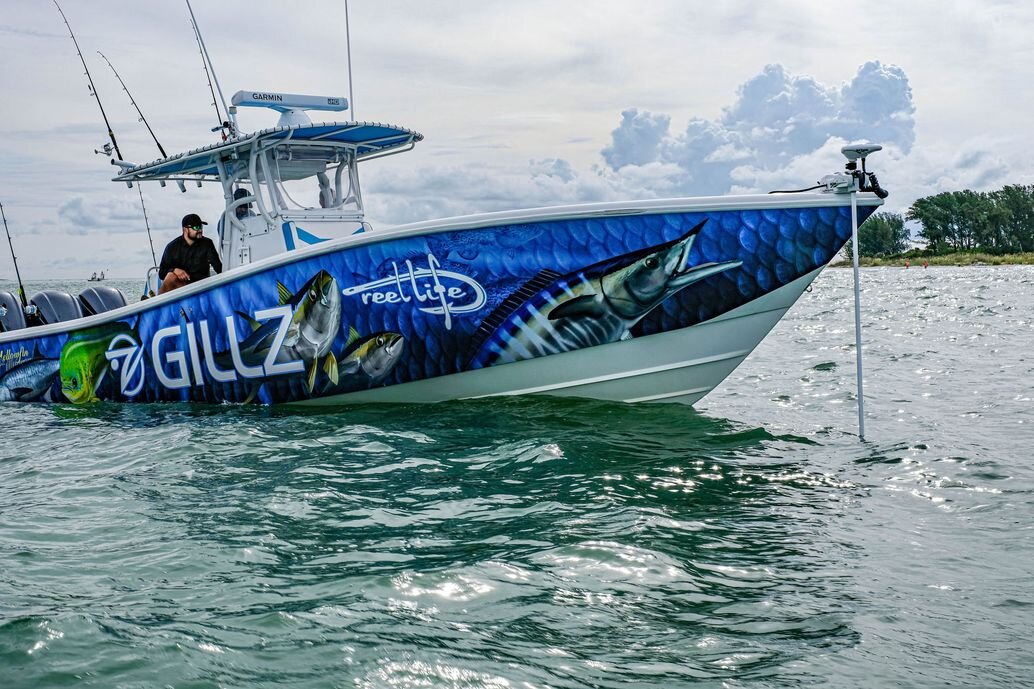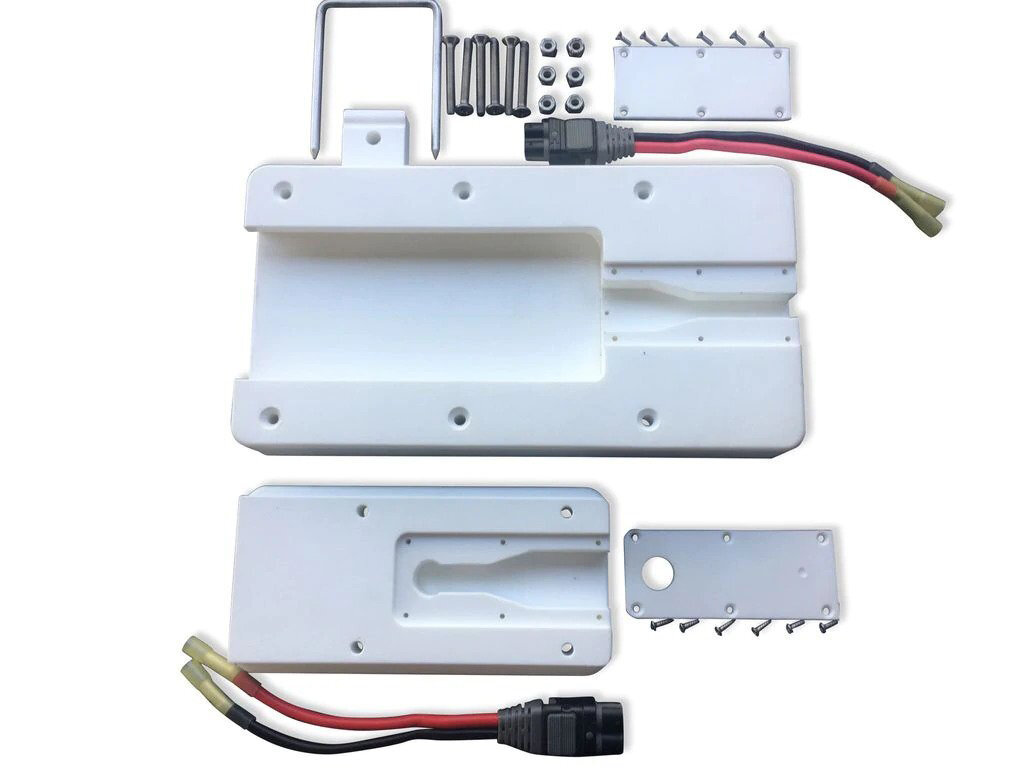Long-Shaft Electric Trolling Motors
Jim Hendricks / Sport Fishing
Offshore anglers have recently discovered the benefits of electric power. Courtesy MinnKota
Until recently, only inshore anglers thought to equip their boats with trolling motors. But as motor manufacturers have rolled out more powerful products with longer shaft lengths, offshore anglers — whose boat bows often rise to imperious heights — have discovered the benefits of electric power.
Trolling motors with shaft lengths of up 87 inches enable offshore anglers to tap advanced features such as a wireless control, virtual anchoring, autopilot and route tracking in the pursuit of pelagic and bottom fish. Minn Kota debuted its 87-inch Riptide Terrova last year, while Rhodan Marine’s 84-inch HD GPS Anchor came out in 2017.
“I use the Minn Kota Riptide Terrova mounted up on the bow pulpit of my Parker 2502 pilothouse boat,” says Jason Arnold, avid angler, freelance photographer and contributor to Sport Fishing. “It works well for vertical jigging for grouper and snapper, as well as kite fishing for sailfish.”
Virtual Anchor
When vertical jigging, Arnold uses the Minn Kota’s virtual anchor mode, call Spot-Lock. The motor’s built-in GPS integrates with the micro-processor to automatically hold the boat in position at the press of a button on the wireless i-Pilot Link remote or, when networked with a Humminbird Solix, Helix or Onix multifunction display, a touchscreen command.
Rhodan Marine’s 84-inch HD GPS Anchor came out in 2017. Courtesy Rhodan Marine
“It’s not only easier than dropping and retrieving an anchor, it’s a more pinpoint way of fishing,” he explains. “I can also jog around to different areas of a wreck and then hit Spot-Lock again for fish each area.”
When kite fishing, Arnold uses the trolling motor in auto-pilot mode to hold the bow of the Parker into the wind, allowing him to deploy kites from the stern. “The first day we used it, we had a quadruple hookup on sailfish,” he says.
High Thrust
To produce the power needed to effectively move or position larger saltwater boats, long-shaft trolling motors all operate on 36 volts DC, which requires a bank of three 12-volt deep-cycle batteries. The Minn Kota produces a maximum of 112 pounds of thrust, while the Rhodan offers 120 pounds of thrust.
How long will batteries last with these motors? That, of course, hinges on initial battery charge, how much thrust you use and for what length of time. But to give you an idea, Arnold has fished with his trolling motor for as long as six hours. “I have never run out of battery power,” says Arnold, who always starts the day with a fully charged battery bank.
Deployment and Control
A drawback to both the Minn Kota and Rhodan models lies in their manual deployment and retrieval. Someone has to go forward and wrestle with the motor. It’s easier on a center console than on a cabin boat such as the Parker 2505.
Trolling motors can make it easier to position the boat for landing fish. Courtesy Minn Kota
Once deployed, however, operation is very easy. Most captains employ the wireless function, which allows control of the motor from virtually any place on the boat, such as the helm, the aft deck or even a tower, using a wireless remote.
Dealing with Waves
One other issue to consider when using a bow-mount electric trolling motor in offshore applications: rough seas. While long shafts keep motors and propellers submerged in relatively calm conditions, sometimes the waves lift the bow too high.
When closely spaced waves build, causing the bow to rise and fall dramatically, the motor periodically comes out of the water and the prop loses its bite. “My motor works in winds up to about 20 mph,” Arnold says. “After that, the waves get too high and the motor keeps popping out of the water.”
Reverse Engineering
As trolling-motor companies engineer models for offshore use, some boat builders have designed offshore boats for trolling-motor use. For example, the Crevalle 33 CSF, a new deep-V center-console fishing boat, features a dedicated trolling motor mounting surface on the forepeak, much like that of many bay and hybrid boats.
One issue to consider when using a bow-mount electric trolling motor in offshore applications is rough seas. Courtesy Rhodan Marine
“We see increasing numbers of anglers using bow-mount trolling motors for offshore fishing,” says Ken Russell, chief operating officer for Crevalle Boats, based in Wildwood, Florida. “That’s why we built the 33 CSF with a trolling motor pad.”
The 87-inch Minn Kota Riptide Terrova starts at $2,999.99, and the 84-inch Rhodan HD GPS Anchor starts at $2,999.
Pucks make it easier for anglers to remove bow-mount motors when needed. Courtesy Power Pux
Quick-Release Brackets
Quick-release trolling-motor brackets—known colloquially as pucks—make it easier for anglers to remove bow-mount motors when needed. With the pull of a pin, you can easily clear the forward deck for fly fishing or cast-netting, or remove the motor at home to prevent theft. Re-mounting is just as quick.
Most trolling-motor brands offer such devices as optional accessories, but a new one on the aftermarket from Power Pux includes a water-resistant electrical socket and plug, rated for up to 60 amps, built into the assembly. Everything connects as you slide the trolling motor into the polyethylene base of the puck. A stainless-steel, locking double pin secures the motor.
With the GPS-guided motors that are so popular among today’s saltwater anglers, this completely eliminates any external power cords that can create snags or trip points.
To ease retrofits, the Power Pux bolt pattern matches that of popular quick-release bases currently on the market. The brand also offers an optional cover to protect the base when the motor is not installed.
A Power Pux kit—including wiring pigtails, hardware and padlock— sells for $499.99.





